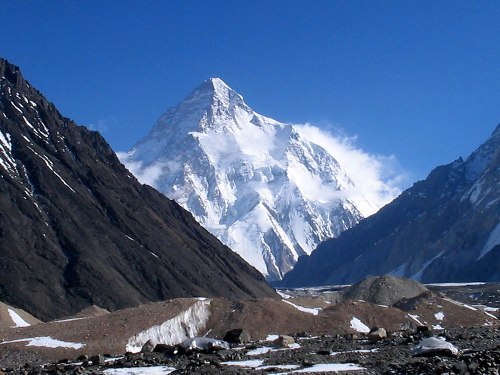MUNDO VASTO MUNDO
KARAKORUM - MONGÓLIA


| Dictionary, Encyclopedia and |
Karakorum
|
Also found in: Dictionary/thesaurus, Wikipedia | 0.01 sec. |
Ads by Google
Extracto baga Goji 500 mg
Extracto de Lycium barbarum. Normalizado 40% polissacáridos. www.Super-Smart.eu  Karakorum, ruined city, Mongolia
Karakorum (kä'rəkō`rəm),
ruined city, central Republic of
Mongolia, near the Orkhon River, SW of
Ulaanbaatar.
The area around Karakorum had been inhabited by nomadic
Turkic tribes from the 1st cent. A.D., but the city itself was not laid
out until c.1220, when Jenghiz Khan, founder of the Mongol empire,
established his residence there. As capital of the Mongols
, Karakorum was visited (c.1247) by a papal mission under Giovanni
Carpini. The city was abandoned (and later destroyed) after Kublai Khan,
grandson of Jenghiz, transferred (1267) the Mongol capital to Khanbaliq
(modern Beijing). The noted Lamaist monastery of Erdeni Dzu was built
nea
r Karakorum in 1586. The ruins of the ancient Mongol city were
discovered in
1889 by N. M. Yadrinstev, a Russian explorer, who also
uncovered the Orkhon
Inscriptions (see Orkhon
). Karakorum is also the name of a nearby site, which in
the 8th and 9th cent
was the capital of the Uigurs
. Karakorum, mountain range, KashmirKarakorum or Karakoram, mountain range, extending c.300 mi (480 km), between the Indus and Yarkant rivers, N Kashmir, S central Asia; SE extension of the Hindu Kush . It covers disputed territory, held by China on the north, India on the east, and Pakistan on the west. Karakorum's main range ha s some of the world's highest peaks, including K2 (Mt. Godwin-Austen; 28,250 ft/8,611 m), the second highest peak in the world. Karakorum also has several of the world's largest glaciers. Its southern slopes are the watershed for many tributaries of the Indus River. The mountains, the greatest barrier between India and central Asia, are crossed above the perpetual snow line by two natural routes. Karakorum Pass (alt. 18,290 ft/5,575 m), the chief pass, is on the main Kashmir-China route. Another important pass, Khunjerab (Kunjirap) Pass (alt. 15,420 ft/4,700 m), is on the Pakistan-China route (see Hunza ).
The
Columbia Electronic Encyclopedia® Copyright © 2007, Columbia
University Press. Licensed from Columbia University Press. All rights reserved. www.cc.columbia.edu/cu/cup/
Ads by Google
Law firm in Mongolia
International law firm in Mongolia with full presence (+15 years) www.lehmanlaw.mn KarakorumAncient capital, Mongol empire. Its ruins lie on the upper Orhon Riverin north-central Mongolia. It was settled c. 750. Genghis Khan established his headquarters there in 1220. In 1235 his son and successor, Ögödei, enclosed the city with walls and built a palace. Chinese forces invaded Mongolia and destroyed Karakorum in 1388. It was later partially rebuilt but was abandoned by the 16th century. The ruins are included in a regional UNESCO World Heritage site designated in 2004.
For more information on Karakorum, visit Britannica.com. Britannica Concise
Encyclopedia. Copyright © 1994-2008 Encyclopædia Britannica, Inc.
Ads by Google
Lições de Inglês Grátis
Receba Lições de Inglês 100% Grátis e Comece a Falar como um Nativo! Englishtown.com/Licoes_Gratis Karakorum
a ruined city in Mongolia: founded in 1220 by Ghenghis Khan; destroyed
by Kublai Khan when his brother rebelled against him, after Kublai Khan had moved his capital to Peking (now Beijing)
Collins Discovery Encyclopedia, 1st edition © HarperCollins Publishers 2005
Ads by Google
Dicionário De Sinônimos
Pesquise No Dicionário Agora Com O. Aplicativo Grátis Feito Para Seu PC www.minhainternetinteligente.com
Warning! The following article is from The Great Soviet Encyclopedia (1979)
Karakorum. It might be outdated or ideologically biased.
(Mongolian,
Khara-Khorin), capital of the ancient Mongolian empire.
Founded by Genghis Khan in 1220, the city existed until the 16th century. Its ruins are located on the upper Orkhon River. Information about Karakorum is contained in Chinese chronicles and the notes of the 13th-century European travelers Giovanni de Piano Carpini, Marco Polo, and Guillaume Rubruquis. The Russian scholar N. M. Iadrintsev investigated the ruins of Karakorum in the late 19th century. By analyzing historical sources, A. M. Pozdneev confirmed the city’s location at the Buddhist monastery of Erdeni Dzuu (built in 1585 in the southern part of Karakorum). In 1948–49 a joint Soviet-Mongolian expedition, under the direction of S. V. Kiselev, conducted excavations at Karakorum. The remains of the palace of Ugedei, which was built on a granite foundation, were discovered in the southwestern part of the city. The remains of a Buddhist shrine with wall paintings, dating from the late 12th century or early 13th century, were discovered. The trade and artisan quarter s and other objects were investigated in the central part of the city. Plowed fields irrigated by canals were located to the east of the city. REFERENCESAtlas drevnostei Mongolii, fasc. 1. St. Petersburg, 1899.Pozdneev, A. Mongoliia i mongoly, vols. 1–2. St. Petersburg, 1896–98. Iadrintsev, N. M. “Puteshestvie na verkhov’ia Orkhona k razvalinam Karakoruma.” Izvestiia russkogo geograficheskogo obshchestva, 1890, vol. 26, issue 4. Drevnemongol’skie goroda. Moscow, 1965.
L. A. EVTIUKHOVA
The Great Soviet Encyclopedia, 3rd Edition (1970-1979). © 2010
The Gale Group, Inc. All rights reserved. Want to thank TFD for its existence? Tell a friend about us, add a link to this page, add the site to iGoogle, or visit the webmaster's page for free fun content. Link to this page: |
Nenhum comentário:
Postar um comentário